#swapo
Explore tagged Tumblr posts
Link
SWAPO Member of Parliament Veiko Nekundi has levelled allegations against the Bank of Namibia and commercial banks in Namibia, stating that they discriminate against disadvantaged Namibians and overcharge them on banking fees, despite the economic downturn experienced by many.
#SWAPO#accuses#banks#discrimination#banking fees#downturn#higher charges#Namibia#news#via Energy100FM#world news
0 notes
Text
youtube
Onukpa Swapo - Bokoor Band (Bokoor Band, 1978)
#Onukpa Swapo#Soul#Soul Music#Soul Music Songs#Music#Music Songs#Bokoor Band#1978#Harmonica#Bokoor Records#Youtube
8 notes
·
View notes
Text
Like I really do wish people remembered more about the Anti-Imperial struggles of Southern Africa in the late 20th century. As incomplete as their revolutions may have been, with the politically free nations succumbing to the overwhelming force of Western Imperialism and being taken over by neo-colonial comprador regimes, what they did manage to achieve was still so very impressive. A struggle for human dignity against the most openly cruel and brutish forms of colonialism, the mobilisation and education of the most impoverished and super-exploited people on the planet in the name of not only liberating their own people but with the understanding that they were advancing the interests of humanity as a whole. Nationalist in character and internationalist in spirit, seeking to build independent nations that could co-operate in solidarity with all the progressive minded peoples of the world. Introducing healthcare, education and fair exchange into the forgotten and exploited parts of their country, giving a purpose to millions who enthusiastically gave their lives to defend and advance their gains both material and psychological.
The MPLA in Angola, FRELIMO in Mozambique, the alliance of ZANU and ZAPU in Zimbabwe, SWAPO in Namibia and the ANC of South Africa. It's also worth remembering the PAIGC of Guinea-Bissau and Cape Verde who, despite their geographical separation, faced a common enemy and so forged deep bonds with their comrades to the south. Whatever their eventual fates after independence, triumphs and failures alike, the struggles they fought against the reactionary White Supremacist regimes of Portugal, Rhodesia and South Africa were nothing short of heroic. Despite vast differences in space and time, I think these struggles hold both inspiration and lessons for progressives peoples all over the world to this day. It's truly a great shame how much they've been forgotten, these conflicts only ever brought up as a footnote to something more well known rather than as an area of interest in their own right.
If you're curious, the Africa section of the Marxist Internet Archive has a lot of good material from the period that's a good place to start learning more, even if it is rather lacking in information from the latter portion of the struggle. ARG's Race to Power gives a good overview of the general situation in Southern Africa as of 1971, while LSM has some good general collection of material collected from Angola, Mozambique and Guinea-Bissau. The entire LSM "Life Histories from Revolution" series provides some really interesting first hand ground-level accounts of the conditions of life under Imperialism and the movements that formed to oppose it, while their Interviews with Liberation Movement Leaders provides the views of people higher up in the revolutionary movements. I'd recommend checking them out to at least broadly familiarise yourself with these tragically neglected struggles.
131 notes
·
View notes
Text
PT. 2: FORMER CIA AGENT SPILLS ON WAR AGAINST THIRD WORLD
Most people don’t know a fraction of the CIA’s crimes against humanity.
In this 1988 video clip, former CIA agent John Stockwell exposed a few of the US intelligence agency’s activities.
From death squads in Central America to brutal wars against revolutionaries in Korea and Vietnam, the countries of the Global South have been under constant attack since capitalism first emerged in Western Europe and, later, when the United States became a hegemon, dominating the world following the Second World War.
Of course, the West has not spared Africans. Stockwell participated in CIA operations in Angola, assisting reactionary groups such as the National Union for the Total Independence of Angola (UNITA), led by anti-communist Jonas Savimbi. The political party’s goal was crushing the revolutionary People’s Movement for the Liberation of Angola (MPLA).
But this was not limited to Angola. It was also a war against the South West African People’s Organisation (SWAPO) of Namibia and the African National Congress (ANC) in South Africa.
And, today, we can relate to the Palestinian national liberation struggle because we continue our liberation struggle.
And, so, we will not forget the crimes of the CIA and its collaborators.
32 notes
·
View notes
Text
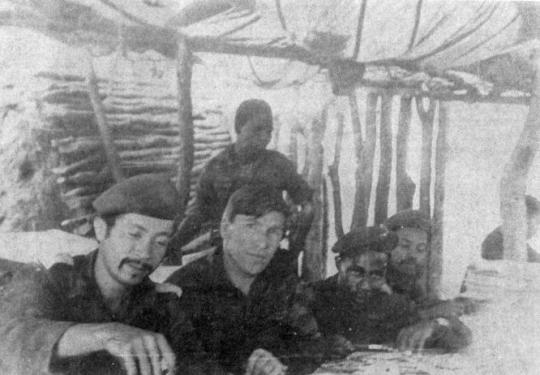
Soviet military advisers with Namibian SWAPO guerrillas during the South African Border War, late 1970
42 notes
·
View notes
Text
youtube
On Palestine, G4S, and the Prison-Industrial Complex Speech at SOAS in London
(Angela Davis, December 13, 2013)
Transcript from the book Freedom Is a Constant Struggle
When this event highlighting the importance of boycotting the transnational security corporation G4S was organized, we could not have known that it would coincide with the death and memorialization of Nelson Mandela.
As I reflect on the legacies of struggle we associate with Mandela, I cannot help but recall the struggles that helped to forge the victory of his freedom and thus the arena on which South African apartheid was dismantled. Therefore I remember Ruth First and Joe Slovo, Walter and Albertina Sisulu, Govan Mbeki, Oliver Tambo, Chris Hani, and so many others who are no longer with us. In keeping with Mandela’s insistence of always locating himself within a context of collective struggle, it is fitting to evoke the names of a few of his comrades who played pivotal roles in the elimination of apartheid.
While it is moving to witness the unanimous and continued outpouring of praise for Nelson Mandela, it is important to question the meaning of this sanctification. I know that he himself would have insisted on not being elevated, as a single individual, to a secular sainthood, but rather would have always claimed space for his comrades in the struggle and in this way would have seriously challenged the process of sanctification. He was indeed extraordinary, but as an individual he was especially remarkable because he railed against the individualism that would single him out at the expense of those who were always at his side. His profound individuality resided precisely in his critical refusal to embrace the individualism that is such a central ideological component of neoliberalism.
I therefore want to take the opportunity to thank the countless numbers of people here in the UK, including the many then-exiled members of the ANC and the South African Communist Party, who built a powerful and exemplary antiapartheid movement in this country. Having traveled here on numerous occasions during the 1970s and the 1980s to participate in antiapartheid events, I thank the women and men who were as unwavering in their commitment to freedom as was Nelson Mandela. Participation in such solidarity movements here in the UK was as central to my own political formation as were the movements that saved my life.
As I mourn the passing of Nelson Mandela I offer my deep gratitude to all of those who kept the antiapartheid struggle alive for so many decades, for all the decades that it took to finally rid the world of the racism and repression associated with the system of apartheid. And I evoke the spirit of the South African Constitution and its opposition to racism and anti-Semitism as well as to sexism and homophobia.
This is the context within which I join with you once more to intensify campaigns against another regime of apartheid and in solidarity with the struggles of the Palestinian people. As Nelson Mandela said, “We know too well that our freedom is incomplete without the freedom of the Palestinians.”
Mandela’s political emergence occurred within the context of an internationalism that always urged us to make connections among freedom struggles, between the Black struggle in the southern United States and the African liberation movements—conducted by the ANC in South Africa, the MPLA in Angola, SWAPO in Namibia, FRELIMO in Mozambique, and PAIGC in Guinea Bissau and Cape Verde. These international solidarities were not only among people of African descent but with Asian and Latin American struggles as well, including ongoing solidarity with the Cuban revolution and solidarity with the people struggling against US military aggression in Vietnam.
A half-century later we have inherited the legacies of those solidarities—however well or however badly specific struggles may have concluded—as what produced hope and inspiration and helped to create real conditions to move forward.
We are now confronted with the task of assisting our sisters and brothers in Palestine as they battle against Israeli apartheid today. Their struggles have many similarities with those against South African apartheid, one of the most salient being the ideological condemnation of their freedom efforts under the rubric of terrorism. I understand that there is evidence indicating historical collaboration between the CIA and the South African apartheid government—in fact, it appears that it was a CIA agent who gave SA authorities the location of Nelson Mandela’s whereabouts in 1962, leading directly to his capture and imprisonment.
Moreover, it was not until the year 2008—only five years ago—that Mandela’s name was taken off the terrorist watch list, when George W. Bush signed a bill that finally removed him and other members of the ANC from the list. In other words when Mandela visited the US after his release in 1990, and when he later visited as South Africa’s president, he was still on the terrorist list and the requirement that he be banned from the US had to be expressly waived.
The point I am making is that for a very long time, Mandela and his comrades shared the same status as numerous Palestinian leaders and activists today and that just as the US explicitly collaborated with the SA apartheid government, it continues to support the Israeli occupation of Palestine, currently in the form of over $8.5 million a day in military aid. We need to let the Obama administration know that the world knows how deeply the US is implicated in the occupation.
It is an honor to participate in this meeting, especially as one of the members of the International Political Prisoners Committee calling for the freedom of Palestinian political prisoners, recently formed in Cape Town, and also as a member of the jury of the Russell Tribunal on Palestine. I would like to thank War on Want for sponsoring this meeting and progressive students, faculty, and workers at SOAS, for making it possible for us to be here this evening.
This evening’s gathering specifically focuses on the importance of expanding the BDS movement—the boycott, divestment, and sanctions movement called for by Palestinian civil society—which has been crafted along the lines of the powerful model of the antiapartheid movement with respect to South Africa. While there numerous transnational corporations have been identified as targets of the boycott, Veolia for example, as well as Sodastream, Ahava, Caterpillar, Boeing, Hewlett Packard, and others, we are focusing our attention this evening on G4S.
G4S is especially important because it participates directly and blatantly in the maintenance and reproduction of repressive apparatuses in Palestine—prisons, checkpoints, the apartheid wall, to name only a few examples.
G4S represents the growing insistence on what is called “security” under the neoliberal state and ideologies of security that bolster not only the privatization of security but the privatization of imprisonment, the privatization of warfare, as well as the privatization of health care and education.
G4S is responsible for the repressive treatment of political prisoners inside Israel. Through Addameer, directed by Sahar Francis, we have learned about the terrifying universe of torture and imprisonment which is faced by so many Palestinians but also about their hunger strikes and other forms of resistance.
G4S is the third-largest private corporation in the world—behind Walmart, which is the largest, and Foxconn, the second largest.
On the G4S website, one discovers that the company represents itself as capable of providing protection for a broad range of “people and property,” from rock stars and sports stars to “ensuring that travelers have a safe and pleasant experience in ports and airports around the world to secure detention and escorting of people who are not lawfully entitled to remain in a country.”
“In more ways than you might realize,” the website reads, “G4S is securing your world.” We might add that in more ways that we realize, G4S has insinuated itself into our lives under the guise of security and the security state—from the Palestinian experience of political incarceration and torture to racist technologies of separation and apartheid; from the wall in Israel to prison-like schools in the US and the wall along the US-Mexico border. G4S-Israel has brought sophisticated technologies of control to HaSharon prison, which includes children among its detainees, and Damun prison, which incarcerates women.
Against this backdrop, let us explore the deep involvement of G4S in the global prison-industrial complex. I am not only referring to the fact that the company owns and operates private prisons all over the world, but that it is helping to blur the boundary between schools and jails. In the US schools in poor communities of color are thoroughly entangled with the security state, so much so that sometimes we have a hard time distinguishing between schools and jails. Schools look like jails; schools use the same technologies of detection as jails and they sometimes use the same law enforcement officials. In the US some elementary schools are actually patrolled by armed officers. As a matter of fact, a recent trend among school districts that cannot afford security companies like G4S has been to offer guns and target practice to teachers. I kid you not.
But G4S, whose major proficiencies are related to security, is actually involved in the operation of schools. A website entitled “Great Schools” includes information on Central Pasco Girls Academy in Florida, which is represented as a small alternative public school. If you look at the facilities page of the G4S website you will discover this entry: “Central Pasco Girls Academy serves moderate-risk females, ages 13-18, who have been assessed as needing intensive mental health services.” G4S indicates that they use “gender-responsive services” and that they address sexual abuse and substance abuse, et cetera. While this may sound relatively innocuous, it is actually a striking example of the extent to which security has found its way into the educational system, and thus also of the way education and incarceration have been linked under the sign of capitalist profit. This example also demonstrates that the reach of the prison-industrial complex is far beyond the prison.
This company that provides “security” for numerous agencies as well as rehabilitation services for young girls “at risk” in the United States, while operating private prisons in Europe, Africa, and Australia, also provides equipment and services to Israeli checkpoints in the West Bank along the route of Israel’s apartheid wall as well as to the terminals from which Gaza is kept under continuous siege. G4S also provides goods and services to the Israeli police in the West Bank, while it offers security to private businesses and homes in illegal Israeli settlements in occupied Palestine.
As private prison companies have long recognized, the most profitable sector of the prison-industrial complex is immigrant detention and deportation. In the US, G4S provides transportation for deportees who are being ushered out of the US into Mexico, thus colluding with the increasingly repressive immigration practices inside the US. But it was here in the UK where one of the most egregious acts of repression took place in the course of the transportation of an undocumented person.
When I was in London during the month of October, speaking at Birkbeck School of Law, I spoke to Deborah Coles, codirector of the organization Inquest, about the case of Jimmy Mubenga, who died at the hands of G4S guards in the course of a deportation from the UK to Angola. On a British Airways plane, handcuffed behind his back, Mubenga was forcibly pushed by G4S agents against the seat in front of him in the prohibited “carpet karaoke” hold in order to prevent him from vocalizing his resistance. The use of such a term for a law enforcement hold, albeit illegal, is quite astonishing. It indicates that the person subject to the hold is compelled to “sing into the carpet”—or in the case of Mubenga—into the upholstered seat in front, thus rendering his protests muffled and incomprehensible. As Jimmy Mubenga was held for forty minutes, no one intervened. By the time there was finally an attempt to offer him first aid, he was dead.
This appalling treatment of undocumented immigrants from the UK to the US compels us to make connections with Palestinians who have been transformed into immigrants against their will, indeed into undocumented immigrants on their own ancestral lands. I repeat—on their own land. G4S and similar companies provide the technical means of forcibly transforming Palestinian into immigrants on their own land.
As we know, G4S is involved in the operation of private prisons all over the world. The Congress of South African Trade Unions (CO-SATU) recently spoke out against G4S, which runs the Mangaung Correctional Centre in the Free State. The occasion for their protest was the firing of approximately three hundred members of the police union for staging a strike. According to the COSATU statement:
G4S’s modus operandi is indicative of two of the most worrying aspects of neoliberal capitalism and Israeli apartheid: the ideology of “security” and the increasing privatization of what have been traditionally state run sectors. Security, in this context, does not imply security for everyone, but rather, when one looks at the major clients of G4S Security (banks, governments, corporations etc.) it becomes evident that when G4S says it is “Securing your World,” as the company slogan goes, it is referring to a world of exploitation, repression, occupation and racism.
When I traveled to Palestine two years ago with a delegation of indigenous and women-of-color scholar/activists, it was the first time the members of the delegation had actually visited Palestine. Most of us had been involved for many years in Palestine solidarity work, but we were all thoroughly shocked to discover that the repression associated with Israeli settler colonialism was so evident and so blatant. The Israeli military made no attempt to conceal or even mitigate the character of the violence they inflicted on the Palestinian people.
Gun-carrying military men and women—many extremely young—were everywhere. The wall, the concrete, the razor wire everywhere conveyed the impression that we were in prison. Before Palestinians are even arrested, they are already in prison. One misstep and one can be arrested and hauled off to prison; one can be transferred from an open-air prison to a closed prison.
G4S clearly represents these carceral trajectories that are so obvious in Palestine but that also increasingly characterize the profit-driven moves of transnational corporations associated with the rise of mass incarceration in the US and the world.
On any given day there are almost 2.5 million people in our country’s jails, prisons, and military prisons, as well as in jails in Indian country and immigrant detention centers. It is a daily census, so it doesn’t reflect the numbers of people who go through the system every week or every month or every year. The majority are people of color. The fastest-growing sector consists of women —women of color. Many are queer or trans. As a matter of fact, trans people of color constitute the group most likely to be arrested and imprisoned. Racism provides the fuel for maintenance, reproduction, and expansion of the prison-industrial complex.
And so if we say abolish the prison-industrial complex, as we do, we should also say abolish apartheid, and end the occupation of Palestine!
In the United States when we have described the segregation in occupied Palestine that so clearly mirrors the historical apartheid of racism in the southern United States of America—and especially before Black audiences—the response often is: “Why hasn’t anyone told us about this before? Why hasn’t anyone told us about the segregated highways leading from one settlement to another, about pedestrian segregation regulated by signs in Hebron—not entirely dissimilar from the signs associated with the Jim Crow South. Why hasn’t anyone told us this before?”
Boycott G4S! Support BDS!
Just as we say “never again” with respect to the fascism that produced the Holocaust, we should also say “never again” with respect to apartheid in South Africa, and in the southern US. That means, first and foremost, that we will have to expand and deepen our solidarity with the people of Palestine. People of all genders and sexualities. People inside and outside prison walls, inside and outside the apartheid wall.
Palestine will be free!
Thank you.
25 notes
·
View notes
Text
Namibia 2023/24 - Tag 21
Herrschaften und Oukies!!!
Heute Morgen waren wir wieder einmal mit Hans-Dieter Göthje von Kallisto Tours verabredet.
Bereits 2020, in der "dunklen" Corona Zeit, hatten wir die Gelegenheit mit ihm 2 tolle Touren zu unternehmen.
Hans-Dieter Göthje war der letzte, weiße Bürgermeister von Swakopmund, bevor die Riege der SWAPO Mitglieder dieses Amt übernahmen.

Hans-Dieter ist ein Swakopmunder Urgestein. Er selbst war 21 Jahre im Stadtrat tätig und dann noch weiter im Regionalrat der Erongoregion. Wenn der sich hier nicht auskennt - wer bitteschön dann!
Mit Hans- Dieter ging es heute zum zweiten Mal auf eine historische Stadttour durch Swakopmund - und wer könnte darüber besser berichten, als jemand, der die Gründerväter noch persönlich kannte?

Eben! Einen besseren Zeitzeugen gibt es nicht. Der Großvater, Kurt Trede, kam mit der Woermann Linie ins Land. Er war dort als Schiffsstewart tätig und beschloss eines Tages ebenfalls sein Glück in der deutschesten aller deutschen Städte - in Swakopmund - in Deutsch-Südwest zu machen.
Er eröffnete ein Spielwarengeschäft in der Stadtmitte, in allerbester Lage, Ecke Moltke Straße / Kaiser Wilhelm Straße. Das Haus, bekannt als Kurt-Trede-Ecke, steht heute noch.
Gegründet wurde Swakopmund von den deutschen Schutztruppen, im Jahr 1892. Der einzige brauchbare natürliche Hafen, nämlich Walvis Bay, war schon seit 1878 von den Engländern besetzt.

Man musste also eine andere Lösung finden. Die deutsche Kolonie Südwest-Afrika sollte entwickelt werden. Und dafür mussten viele Waren per Schiff aus der Heimat heran geschifft werden.

Der Hauptmann der Schutztruppe Curt von Francois wurde losgeschickt, um eine geeignete Stelle für einen Hafen zu finden. Und er fand die Mündung des Swakop Flusses. Der hieß eigentlich Tsoakhaub, ein Wort aus der Sprache des Nama Stammes. Das konnte aber niemand aussprechen, also wurde daraus Swakop.

Da alle Waren vom deutschen Reich in die Kolonie Deutsch-Südwestafrika über Swakopmund abgewickelt wurden, entwickelte sich der Ort schnell. 1909 bekam Swakopmund das Stadtrecht. Doch während des ersten Weltkrieges gaben die Deutschen Swakopmund praktisch auf.
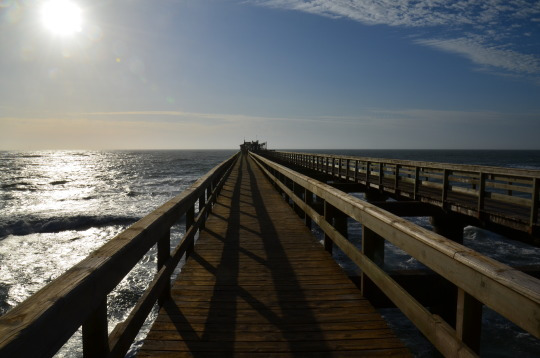
Unsere Tour begann natürlich unten an der Mole und der Jetty, wo quasi alles seinen Anfang nahm. Hans-Dieter hatte natürlich zu jedem Punkt historisches Bildmaterial parat, anhand dessen können wir das Damals mit dem heutigen Stand vergleichen.

Erst 1905 wurde ein 325 Meter langer hölzerner Landungssteg fertiggestellt, der später durch eine solidere Konstruktion aus Eisen ersetzt wurde. Swakopmund wurde dadurch zum Tor für Deutsch-Südwestafrika.
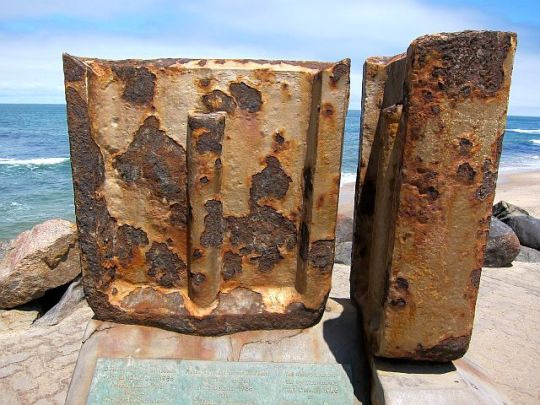
Die gesamte Versorgung der Kolonie wurde über den kleinen Ort abgewickelt. 1902 konnte die Schmalspur-Eisenbahn nach Windhoek in Betrieb genommen werden.
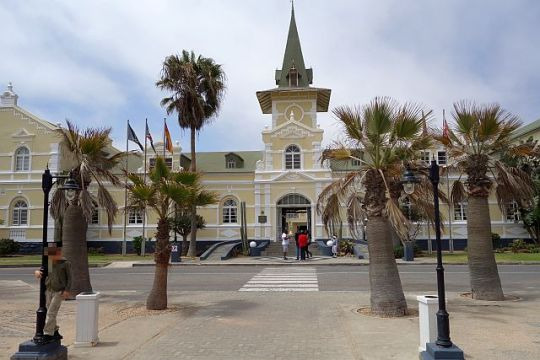
Der Bahnhof im wilhelminischen Stil stammt aus dem gleichen Jahr. Er wurde vor einigen Jahren aufwändig restauriert und in ein Vergnügungszentrum mit Spielcasino und Luxushotel umgewandelt.
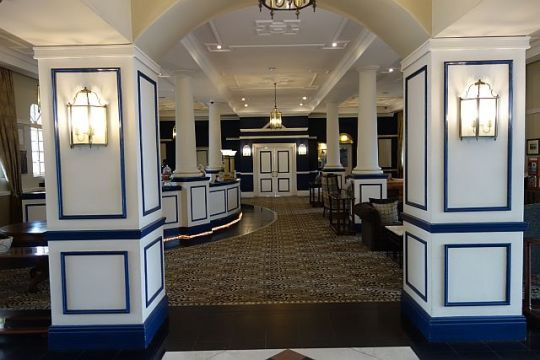
Ein markantes Gebäude ist das Woermann Haus aus dem Jahre 1905. Es vereinigt Fachwerk- und Jugendstil- beziehungsweise wilhelminische Stilelemente.

Dass es in Swakopmund an nichts fehlt und der Swakopmunder nicht auf dem Trockenen sitzen muss, dafür sorgte die Hamburger Woermann-Reederei mit ihrer importierten Ware aus Deutschland.
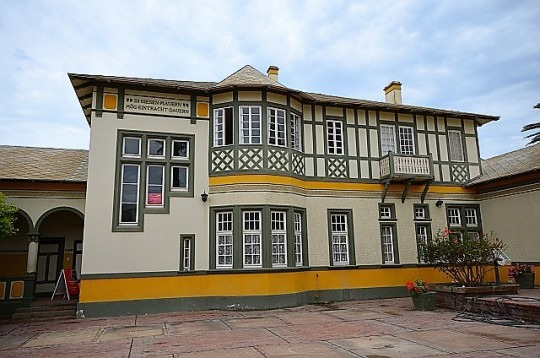
Das ehemalige Handelshaus in der Bismarck Straße mit seinem 25 Meter hohen Damara-Turm und seinem von Arkaden gesäumten Innenhof beherbergt heute die städtische Bibliothek und eine Kunstgalerie.
Ein weiteres Wahrzeichen Swakopmunds ist der alte Leuchtturm. Er ist 21 Meter hoch und wurde im Jahre 1910 in Betrieb genommen. Das heimatkundliche Museum gleich daneben entstand erst Anfang der fünfziger Jahre.
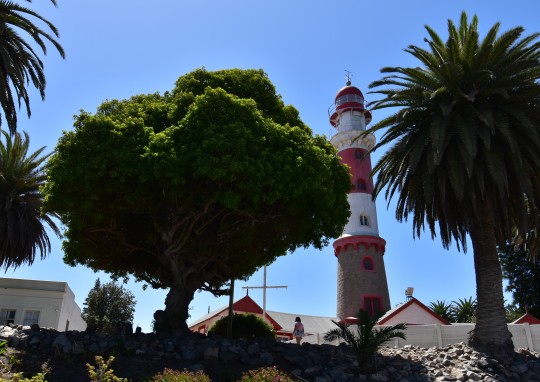
Natürlich steht auch das Hohenzollernhaus auf dem Besichtigungsplan. Früher ein zwielichtiges Hotel, um das sich viele wilde Geschichten ranken, mittlerweile zu seriösen Eigentumswohnungen umgebaut.
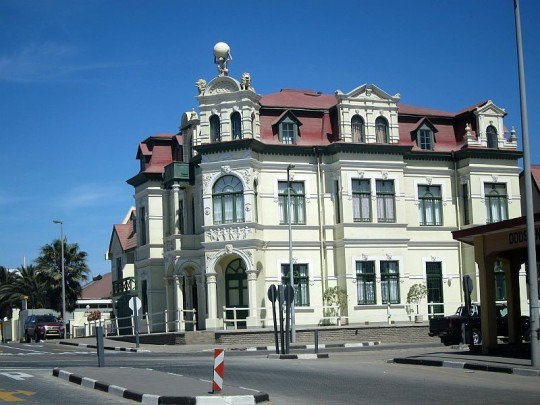
Uns hat die Tour zu den Gründervätern und Anfänger der Stadtentstehung hervorragend gefallen. Jedoch ist soviel geschichtlicher Hintergrund sicherlich nicht jedermanns Sache.
Viele Besucher wundern sich über die oft überdimensionierte Breite der Straßen, die für unsere Verhältnisse in gar keinem Zusammenhang mit dem herrschenden Straßenverkehr stehen.
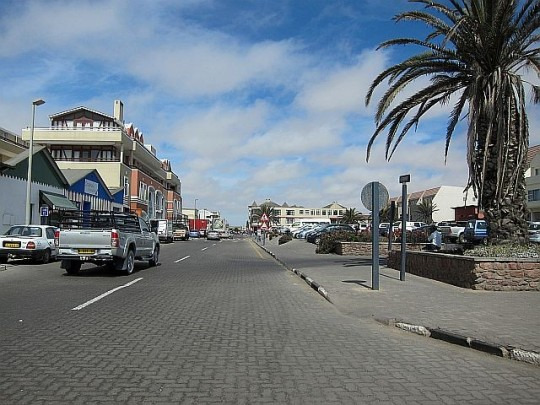
Das hat gar nichts mit dem Betrieb in der Ferienzeit zu tun, sondern liegt auch in der Geschichte der Stadtgründung bzw. der Erschließung des Landes.
Denn die angelieferten Waren wurden von Ochsengespannen mit 16 und mehr Tieren gezogen und die fuhren nicht nur gerade aus, sondern mussten auch gelegentlich wenden. Dazu braucht man Platz - viel Platz.

In der Stadt floss der Schnaps in Strömen und Ochsenwagen um Ochsenwagen hielten Einzug, um mit den Handelsgütern wieder ins Inland abzufahren.
Plötzlich herrschte ein solch reger Verkehr, dass sich die Behörden sogar veranlasst sehen, mittels einer Verordnung die Störung der Sonntagsruhe zu unterbinden.
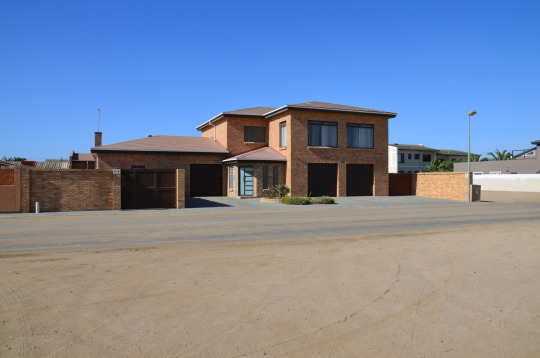
Nach dieser informativen Tour ging es zurück in unsere Wohnung im Stadtteil Kramersdorf, benannt nach der Familie Kramer, deren Haus das Erste war, das hier erbaut wurde.
Für den heutigen Nachmittag hatten wir ursprünglich einen Pelican Point Seal Drive gebucht. Die Tour sollte von Uwe Kessler, dem Eigentümer von Desert Dunes Dust Tours durchgeführt werden.
Leider sagte uns Uwe sehr, sehr kurzfristig ab. - Die zweifelhafte Begründung dieser Absage lautete: ein Kreuzfahrtschiff habe "plötzlich" all seine Fahrzeuge gebucht und nun stehe für uns heute leider keins mehr zur Verfügung. Allerdings könnten wir an einem beliebigen anderen Tag die Tour gerne nachholen. Och, nöö, lass mal!
Wir disponierten kurzfristig um, als meine Mutter mit der Idee um die Ecke kam, sie wolle unbedingt diese komische Welwitschia Pflanze sehen.

Der „Welwitschia Drive“ erstreckt sich südlich der B2 und nördlich der C 28 und ist Teil des Dorob Nationalparks.
Mondlandschaft tauften die deutschen Kolonialherren das unwirkliche Gelände, das sie nahe der namibischen Atlantikküste entdeckten. Graue Erde durchzogen von schroffen Felsen. Kein Wasser, keine Pflanzen, weit und breit nur Staub und Geröll.
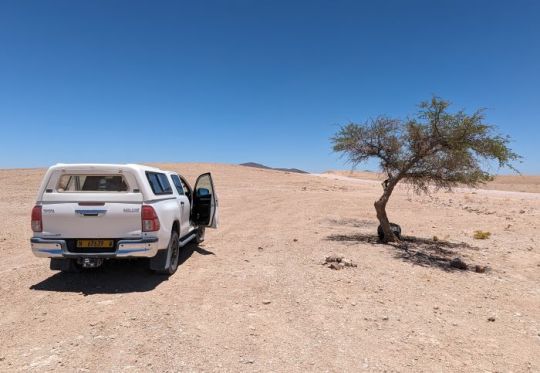
Vor ca. 50 Millionen Jahre kam es zu einem tektonischen Großereignis, dem Auseinanderbrechen des westlichen Gondwana-Kontinents und der damit ausgelösten Öffnung des Atlantischen Ozeans.
Durch die damit verbundene Krustenausdünnung entstanden Schwächezonen in der Erdkruste, die von Doleritschmelzen durchdrungen wurden und die heute für die unzähligen Dolerit-Gänge verantwortlich sind, die sich im Gebiet der Mondlandschaft östlich von Swakopmund ausbreiten. Weicheres Gestein hat sich im Zuge der Erosion immer weiter in seine Bestandteile zerlegt, zurück bleibt der harte Fels.

Hier haben Pflanzenarten überlebt, deren Vielfalt und Einzigartigkeit nur dem aufmerksamen Besucher deutlich werden. Sie haben sich im Laufe der Jahrmillionen an das karge Wüstenklima angepasst, sind Überlebenskünstler geworden in einer feindlich erscheinenden Welt, die doch überall Leben in vielfaltigen Erscheinungsformen hervorbringt.
Wegen der lebensfeindlichen Umweltbedingungen, vornehmlich dem Mangel an Wasser, ist die Vegetation hier sehr verletzlich. Die Pflanzen wachsen extrem langsam. Es kann Jahre dauern, bis wieder günstige Bedingungen herrschen, deshalb ist es wichtig so wenig wie möglich zu zerstören.
Auch Pflanzen, die völlig tot wirken, können nach dem nächsten Regen zu neuem Leben erwachen. Beim Gehen merkt man, dass der Boden an vielen Stellen eine Kruste hat.

Diese besteht zum Teil aus Gips und beherbergt verschiedene Flechtenarten, die als Pionierlebenwesen die ersten Voraussetzungen für das Wachstum komplizierterer Pflanzen bilden.
Wenn ein Auto über solche Flächen fährt, wird diese Kruste zerstört und es werden die Bedingungen für weiteren Pflanzenwuchs erschwert. Auch bleiben Autospuren Jahre lang sichtbar.
Die Welwitschia ist die Nationalpflanze Namibias. Insgesamt soll es in der Umgebung, die als "Welwitschia-Fläche" bekannt ist, rund 50.000 dieser Pflanzen geben.
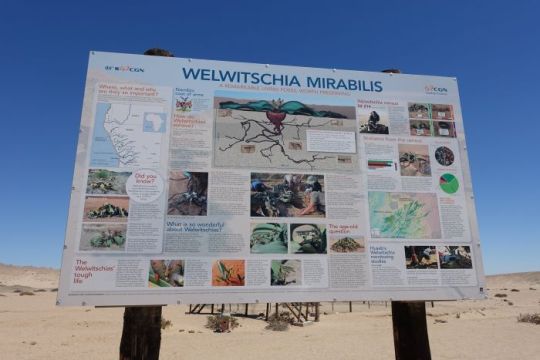
Die größten Felder liegen jedoch im angolanischen Ionapark. Dort hatte der Botaniker Friederich Welwitsch die Pflanze 1859 das allererste Mal für die Wissenschaft entdeckt. Die Exemplare, die er zur Artenbeschreibung nach London verschickte, lösten große Aufregung aus.
Die Welwitschia ist ein immergrüner Zwergbaum mit nur zwei Blättern, die oft gespalten sind. Es ist eine weite Verwandte der Koniferen. Sie hat allerdings auch Eigenschaften der Blütenpflanzen mit getrennten Geschlechtern.
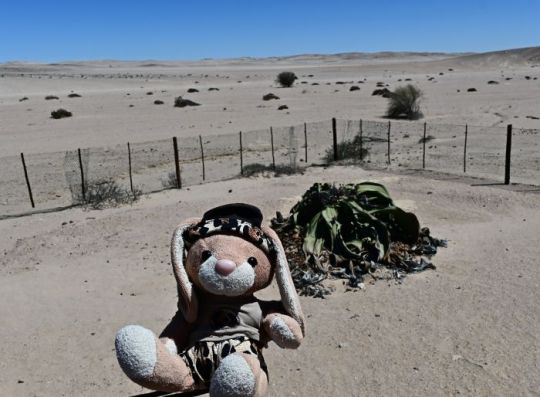
Bis zu 1500 - 2000 Jahre Lebenszeit wird einzelnen Welwitschias in der Namib wissenschaftlich bescheinigt. Je älter sie wird, desto weiter gefächert zeigen sich ihre Blätter. Zahlreiche Theorien wurden über die Welwitschia entwickelt, doch hat man sie bisher nicht wirklich erforscht.
Eigentlich weist sie nur zwei Blätter auf, die einem in der Erde verwurzelten Stamm entspringen. Diese Blätter werden vermutlich jedoch nur zehn bis 15 Jahre alt, wachsen um den aus dem Sand heraus ragenden Stamm herum und reißen dabei immer weiter aus.
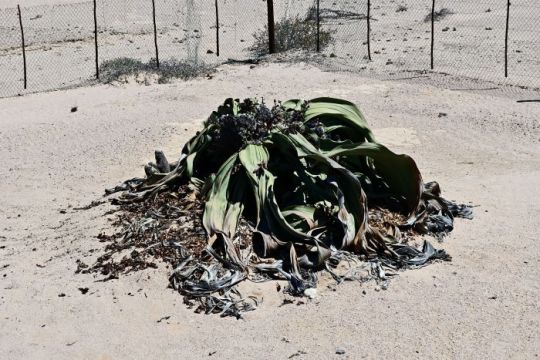
Zum Schutz um die sehr alten Welwitschias wurde oftmals ein Kreis aus Steinen erstellt. Doch leider treten zu viele Besucher in diesen Kreis hinein, um ein nahes Foto aufzunehmen und beachten dabei nicht, dass sie die Pflanze damit zerstören können. Und eine mehr als tausendjährige Pflanze ist nicht zu ersetzen.
Ähnlich verhält es sich mit den vielen unterschiedlichen Flechtenarten der Namib. An das karge Klima angepasst, nutzen unter anderem Bart- und Krusten-Flechten die geringe Feuchtigkeit des Nebels in Küstennähe. So wachsen sie mühselig und bescheiden nur 1 cm in zehn Jahren und dadurch erklärt sich, dass auch nach über 100 Jahren noch die Spuren der kolonialen Ochsenwagen zu erkennen sind.
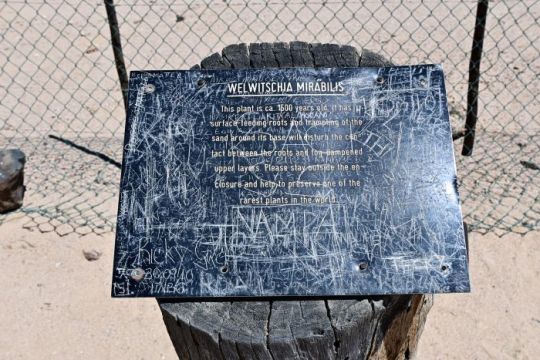
Die zerklüftete Mondlandschaft erweckt den Eindruck, als befände man sich auf einem anderen Planeten. Trocken, rissig, steinig zieht sie sich wie ein Ungetüm aus uralten Zeiten aus Stein und Fels, als Gebirge zwischen Atlantikküste und Namib-Wüste entlang, mit tiefen Schluchten und kargem Gestein beinahe bis zum Horizont.
Ihr zu Füßen liegt das Swakop-Rivier, der Trockenfluss, der nur in guten Regenjahren mit seinen Fluten den Atlantik bei Swakopmund erreicht.
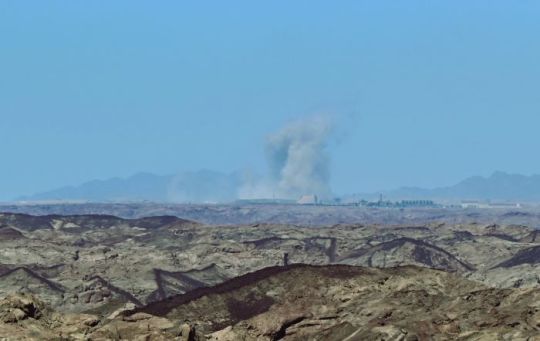
Gegen 18 Uhr treffen wir wieder in Kramersdorf ein. Wir machen uns schnell frisch und dann geht es für uns in das Old Steamers Restaurant, im Alte Brücke Ressort.

Dort wird jeden Abend, ab 18 Uhr, ein tolles Buffet "All you can eat" angeboten. Der Laden ist extrem beliebt und immer weit im voraus ausgebucht.

Mehrere Jahre habe ich vergeblich versucht dort einen Tisch zu bekommen und dieses Mal hat es tatsächlich geklappt.
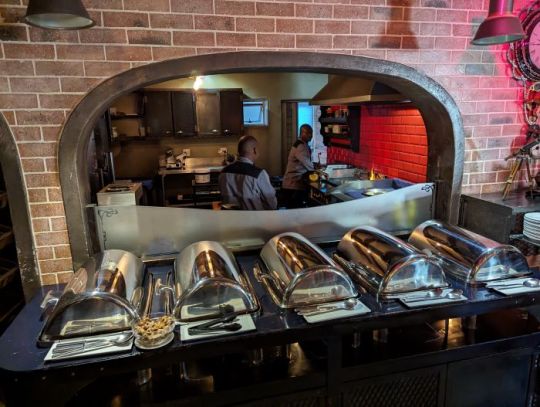
Auch heute kommen noch etliche "walk in" Gäste, die entweder abgewiesen werden oder an der Theke bei einem Drink warten dürfen bis etwas frei wird.
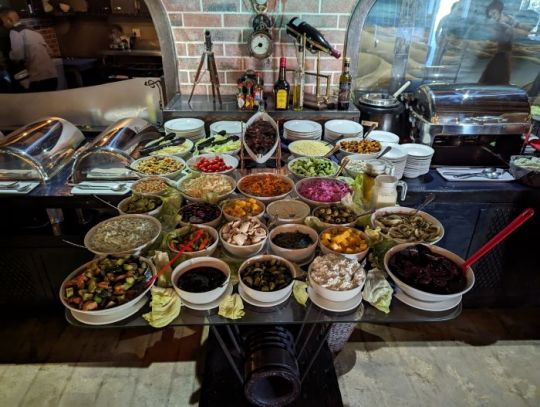
Von uns gibt es für dieses Restaurant eine totale Weiterempfehlung!
Lekker Slaap!
Angie, Micha, Mama und der Hasenbär
10 notes
·
View notes
Text
after much thinking on the backstory arc for Eleni, I decided to reroll her from Imperial Agent to Sith Inquisitor so that way she can be considered as the main Sith Inquisitor in my legacy.
I think over the years after Tenebrae conditioned her to revoke her ability to use the Force due to her inherited the Battle Meditation from her mother Yuthura, she's slowly trying to figure way to regain it back with Kritanta's help. The former was a nod to what Valkorion did to Vaylin.
Eleni trying to recover from the trauma but something did happened within a cave where she and Kriranta encountered the shrine of Revan.
As first I thought rolling her as operative was fitting for her but the lekku + rifle clipping still bothers me to this day, which prompted me to make a change on swapoing her from IA to SI instead.
I wish I had a lot of cartel coins right niw because there's two outfit sets that looks fantastic on her. Imperial Reaper and Intelligence Agent. The latter gives off Sith Inquisitorius vibes tbh.
plus, the thought of her using the Force and took a lightsaber to chop off Malgus' jaw and Tenebrae got scared shitless on his throne chair. probably not happening in my verse since Kritanta wants her to keep her Force reconnection a secret until the time was right.
7 notes
·
View notes
Text
This sort of tweet really annoys me with its how, despite it's supposedly "progressive" viewpoint, it distorts and mangles actual history in order to create a neater narrative that actually weakens one's ability to understand and therefore change the world
Like Apartheid South African and Contemporary Israel have a lot in common; both are white supremacist apartheid Settler States that are intimately tied to and heavily supported by international Imperialist Capitalism (as headed by the USA). They also enjoyed friendly relations with each other and regularly shared ideas and technology, so you have active mutual influence on top of natural convergent evolution. Comparison, as well as contrast, between each regime is a useful way to understand how these sorts of systems function. And yes, observing past trends in one system can help us predict the future of another
But like South Africa and Israel also have a vast number of differences; from their specific relationship with future designs for the peoples they oppressed, to the state of their regional neighbours as well as the overall extent to which other imperialists were willing to openly support them. And these differences in circumstance lead to significant differences in policy.
Like the fact of the matter is this tweet is incredibly misleading; it implies the Apartheid regime of South Africa somehow went berserk in the final years of it's existence when like this political intervention in their northern neighbours had been South African policy since the 1960s. Even before the independence of Angola or Zimbabwe (as well as Mozambique) the South African government had invested considerable sums of money and manpower into propping up the Portuguese and Rhodesian White Settler regimes against the pressure of Anti-Imperial Socialist resistance movements. After the end of Portuguese rule in Africa in 1974 (as their colonial wars drove them bankrupt and exacerbated domestic problems to the point that the Fascist regime found itself overthrown by a Leftist military coup) the South Africans then switched to supporting armed movements of local reactionaries and compradors like UNITA in Angola (which already had a long history of collaboration with the Portuguese) and later RENAMO in Mozambique (whose initial formation was one of the Rhodesian CIO's last significant achievements).
South African attempts to overthrow the Angolan revolutionary government, launching several major offensives with their own ground troops alongside their UNITA puppets while offering plentiful supply, funding and air support to UNITA outside of this, had been policy for as long as there was an Angolan Revolutionary Government to overthrow. And while their had less luck finding useful allies to destabilise Zimbabwe, their cross-border raids were simply an extension of their previous support for Rhodesia. Meanwhile their violations of Zambian sovereignty also were a consistent policy dating back to the 60s due to the Zambian Socialist government's mostly consistent support for the Anti-Imperial resistance movements of Southern Africa. While a deterioration of their relationship with Botswana was a later development, this was mainly a result of political pressure from both other African nations and their own citizens for the Bourgeoisie Botswanan government to stop collaborating with South Africa and to tolerate the presence of anti-apartheid fighters in their territory.
The whole "set-up a puppet government in Namibia" is the most misleading part of all. It implies that Namibia was some sort of independent nation they tried to subvert, and not a colonised territory they outright occupied (de facto since 1922, de jure since 1946; either way since before even the formal inauguration of nation-wide Apartheid in 1948). The attempts to set up a puppet government in Nambia were a direct de-escalation of South African involvement in the territory, prompted by the costly resistance offered by SWAPO and their Angolan Allies. Like if anything the very last years of Apartheid saw a de-escalation of South Africa's aggressive foreign policy, as the social and economic costs of their multiple intense wars had weakened the country and brought the regime close and closer to collapse while even among the Afrikaner Conservatives there was a growing recognition that some sort of compromise with Black Africa was necessary to secure any sort of survival.
And like there were very real material reasons for this, such as the lesser extent of open US support or the inherent contradiction of keeping the indigenous Africans as an oppressed pool of cheap labour which Israel avoided by tending towards outright genocide of Palestinians. It's not like the South African Apartheid regime was morally any better than Israel, just materially different. But these differences must be remembers if we want any chance of actually understanding the situation, instead of just mechanistically applying 1:1 comparisons because it makes an easier story. The nuances of Southern Africa must be appreciated if we want to truly appreciate the history of human struggle against oppression; we can't reduce it to a footnote on whatever conflict it's currently popular to perform activism for.
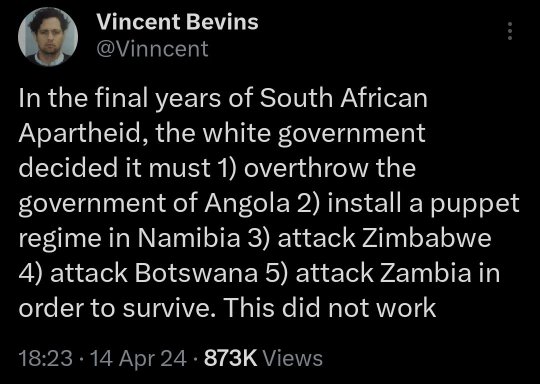
4K notes
·
View notes
Text
Zambia Celebrates 60 Years of Independence
On October 24, 1964, Zambia gained independence from British rule and supported other African liberation movements. Zambia’s founding President, Kenneth Kaunda, played a significant role in helping other African nations’ fights for freedom, such as South Africa’s African National Congress ANC and the Southwest Africa People’s Organization SWAPO, which fought for Namibia’s Independence and other…
youtube
View On WordPress
0 notes
Link
Popular Democratic Movement (PDM) leader McHenry Venaani on Tuesday called on other opposition parties to join a coalition to challenge Swapo’s political supremacy.
He believes that opposition parties stand a chance to win the 2024 national elections if they pool their resources and support together.
“All leaders of opposition political formations must participate in this vocation. If we analyse the ever-changing political dynamic, we will find that building a coalition is the only way to topple Swapo come the next elections,” he said during a press briefing in Windhoek.
#election#votes#ballot#opposition#PDM#Swapo#2024#politics#Windhoek#Namibia#news#via Energy100FM#The Namibian#world news
0 notes
Text
Soul from Ghana
Soul from Ghana in 11 tracks

Aboagyewaa - K. Frimpong and His Cubano Fiestas (K. Frimpong Backed By Vis-A-Vis, 1978)
Africa Is Home - Joe Mensah (Joe Mensah, 1975)
Dankasa - Uppers International (Dankasa/ Neriba Lanchina, 1973)
Kyekye Pe Aware - Sweet Talks (The Kusum Beat, 1976)
Mondo Soul Funky - Ebo Taylor Jnr. With Wuta Wazutu (Gotta Take It Cool, 1978)
Money Is The Root of All Evil - Dan Boandi and the African Internationals (Money Is The Root Of Evil, 1978)
Moving World - Kelenkye Band (Moving World, 1974)
Naam - Christie Azumah & The Uppers International (Din Ya Sugri, 1976)
Onukpa Swapo - Bokoor Band (Bokoor Band, 1978)
Psychedelic Woman - Honey and the Bees Band (originally 1973 / Ghana Soundz: Afrobeat, Funk and Fusion in the 70’s, 2003)
Samari Bolga - Uppers Chapter Two (Walahi Talahi / Samari Bolga, 1976)
More Songs from Africa
Soul from Ghana
African Funk from the Seventies
Ethiopian Grooves
Funk from Africa in 20 tracks
Soul from South Africa: 18 tracks
15 notes
·
View notes
Text
NETUMBO NANDI-NDAITWAH // POLITICIAN
“She is a Namibian politician who is the third and current vice president of Namibia since February 2024. She previously served as the deputy-prime minister of Namibia from 2015 to 2024. The current SWAPO vice president, she has retained her position, and is set to become the party's first female presidential candidate in November 2024. She has also been serving as Namibia's Minister of International Relations and Cooperation since December 2012. From March 2010 to December 2012, she was Minister of Environment and Tourism. Nandi-Ndaitwah is a member of SWAPO, Namibia's ruling party, and a long-time member of the National Assembly. In 2017, Nandi-Ndaitwah was elected vice-president of the Swapo Party at the party's 6th Congress. She is the first woman to serve in that position.”

0 notes
Text
NYERERE: BETTER IF WHITE SETTLERS LEAVE THAN FIGHT Tanzania’s first president was Pan-African socialist leader Julius Nyerere, who turned Dar es Salaam into a regional headquarters for the southern African liberation struggles. During Nyerere’s time, members of the armed anti-colonial freedom forces flocked to Tanzania to establish a base for their fight against White supremacist rule. This included the Mozambican Liberation Front (FRELIMO), the Zimbabwe African People’s Union (ZAPU), the People’s Movement for the Liberation of Angola (MPLA), the South West Africa People’s Organisation (SWAPO) - in what is now Namibia - and the African National Congress of South Africa. In this video, Julius Nyerere explains his position on whether or not White settlers should or would stay in southern Africa once majority rule was established to place Africans in seats of power.
4 notes
·
View notes
Text
Test #1: how much do we really know about history
When looking deeper into the history that has shaped the Ovahimba, I would have never guessed that such events could have even occurred. Some of these topics are not very known when looking into what is being shown to us in the media, everything else is pretty much swept under the rug. Below is a few event that have shaped the Ovahimba people located in Namibia,

Today I will go through a couple of these events, getting in more detail and what each have affected.
1904-1907
The Herero and Namaque Genocide which was the killing of about 50,000 to 65,000 Herero and 10,000 Nama at the hand of German military forces. In 1884, Germany began to formally colonize GSWA (German South West Africa). Several separate native communities, including the Herero, Nama, Damara, San, and Ovambo, lived in the area freely before to colonization. Numerous indigenous communities were subjected to forced labor, land confiscation, and cattle theft during the German occupation.Under the direction of Chief Samuel Maharero, the Herero people launched a massive armed uprising in January 1904 in opposition to the harsh German colonial government. Approximately 123 German colonial settlers were slaughtered by the Herero as a result of the German ruling forces' lack of preparation for the attack. May of 1904, Lieutenant General Lothar von Trotha Supreme Commander of GSWA arrived in GSWA. The Battle of Waterberg killed around 3,000-5,000 Herero warriors, yet some of the Herero were able to escape and headed deep into the Omaheke Desert. Unfortunately the German colonial military forces pursued those who escaped and sadly thousand dies from being shot, from starvation or dehydration, and drinking from bad water. He proceeded to have all males shot at whether armed or not, forcing women and children back to their people and if they did not do so they would be shot at as well. November of 1904, Trotha was overturned and had the remaining Herero put into concentration camps such as the Shark island concentration camp with a mortality rate of 47%-74%. By 1905, the following two years the Nama people in the South fought the Germans using guerrilla tactics, any caught were sent to the same concentration camp as the Herero.
1966-1989
This 23 year long Border war between South Africa and Angola, Angola government and army, all which was supported by Cuban forces as well as a liberation movement UNITA. During the 1960s, racially discriminatory separation caused many in South Africa to resist. Their armed resistance although mounted on black liberation movements, were acts of terrorism directed by the African National Congress, were just "pin pricks". Another tactic was guerrilla movements, against the South African rule in Southwest Africa, later independent Namibia. The collapse of the Portuguese rule in Angola allowed SWAPO (South West African People's Organization) to be able to organize and aid military equip to the people. Unfortunately not everyone was willing to allow/sacrifice their people for the anti-apartheid military campaigns. Yet as for Angola, the Soviet Union provided military machinery, equipment as well as training/trainers.Angola saw around 380,000 Cuban military soldiers stationed there between 1975 and 1991, with a peak level of roughly 55,000. Regardless of whether Angolan or Cuban soldiers entered SWA, the front line would move several hundred miles/kilometers south to the border with South Africa proper if SWAPO acquired control of or destabilized SWA. Although the strategic reasons behind the Border War were not immediately existential for South Africa, they were nonetheless existential because of the possibility of challenges to the nation's territorial integrity.Additionally, there existed a paramilitary internal security organization called Koevoet, which was initially staffed by white South Africans. By using black forces, the number of casualties among white draftees was reduced, which in turn served to reduce political controversy surrounding the Border War. SWAPO was an issue for South Africa. South Africa would not have given a damn that Angola was a Marxist state backed by Soviet equipment and advisors, and that a sizable number of Cubans, including Fidel Castro, were supporting the Angolan government, if SWAPO had not been operating out of Angolan bases. Castro and the Soviet Union grew to believe that South Africa was attempting to overthrow the Angolan Marxist regime in addition to waging a strategic defensive.
2023
Indigenous peoples' rights to self-determination with regard to their claims to lands, territories, and resources have garnered support and attention on a variety of levels throughout the world. Nevertheless, an increasing number of rulings from national and regional courts, UN human rights bodies, and complaint mechanisms show that Indigenous Peoples are still the targets of violations of their human rights connected to commercial and development endeavors, whether by the government or by private entities. As part of their "social license to operate," an increasing number of investors, financial institutions, and companies across a variety of industries have created or are in the process of creating safeguard policies that mandate that they respect the rights of Indigenous Peoples, particularly their right to free, prior, and informed consent (FPIC). This development follows the adoption of the UN Guiding Principles on Business and Human Rights. The Himba people have lived in the Kunene River valley for almost 500 years, making it their ancestral home. With prosperous herds of up to 500 cattle, sheep, and goats per family, they have managed to preserve their way of life. Their cattle and land are strongly related to their economic independence. They have adapted their semi-nomadic pastoral style of life to the severe climate, having had to wander between cattle posts in search of better grazing and water for their animals. The Namibian Constitution prevents discrimination based on ancestry or tribe, however it makes no mention of the rights of Indigenous Peoples. The Himba people need to be able to proactively establish their own goals, policies, and regulations for their lands and resources. Their society, their territory, the lands it includes, and the various resources it contains should all be under their complete authority. By creating or recording their community protocols, the Himba will be able to fully exercise their right to self-governance and enjoy the collective right to self-determination through their own decision-making procedures.
Here are some recent and older documentaries to show some insight on the Ovahimba, as well as a cite that shows different documentaries on the historic events that have taken place overtime.
youtube
0 notes
Text
Africa’s holocaust
By Dr Selwyn R. Cudjoe May 14, 2024 In 1985 I interviewed the president of the South West Africa People’s Organisation (SWAPO) Sam Nujoma when he visited the United Nations Decolonisation Committee to plead for his country’s independence (West Africa, present-day Namibia). Namibia was a German colony from the 1880s to the First World War … Continue reading Africa’s holocaust → http://dlvr.it/T6sMHk
1 note
·
View note